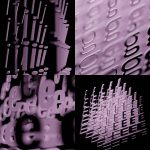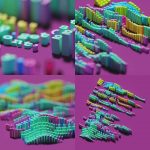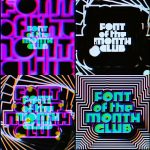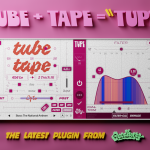In the spirit of an experimental type conference, we experimented with a few interview formats with a few of the speakers. Rob Stenson, a programmer who lives in Southern California and makes lots of typographic things, was game for an epistolary sort of interview, condensed slightly for clarity below.
In preparing for our interview, I reached out to a mutual friend—one that has nothing to do with type or even design, but is in the music scene. He told me he was a fan of yours and the work you’ve done with Vulfpeck, and that you’re some sort of polymath genius. No need to affirm or deny that claim, but maybe you could first tell me about your journey into our tiny little type world from music and programming and tech. Where would you place yourself at all of these intersections?
Rob Stenson: Very kind of our mutual friend to say that, but I think “dilettante” might be a more accurate word, or at least that’s what my grandfather called me once. My most prized possession as a 13-year-old was a big book of New York Times front pages from history. I’d pore over for hours, just loving all the different styles of text layout, in particular how crammed the pages used to be in the ‘60s, when the text in the columns bumped right up against each other. I loved it so much that I even started a newspaper (printed on legal paper) and made my friends write for it, I think just so I could do the page layout. Which I did in Microsoft Word. I’ve loved text for as long as I can remember—reading it, writing it, designing it. And people were always there to encourage the reading and the writing; but not so much the designing. No one around me knew seemed to know anything about typography.
It wasn’t until college, thanks to the internet, that I realized (A) fonts were something you could buy, and (B) type design was something you could do. When the Helvetica documentary came out, it accelerated everything for me. I started thinking about typography all the time—writing a term paper on the history of Times New Roman, attempting to design a few glyphs in Illustrator, dreaming about applying to the Reading MA program when I finished undergrad. But then, slowly, the interest just kind of…faded. Once again, no one around me seemed to know anything about fonts. The closest I ever got was a moment in an English class, when I was sketching a lowercase ‘a’ in my notebook and a girl leaned over and said, “Are you designing a font? That’s what my uncle does.” I said something dumb, like “Oh that’s cool,” without having the presence of mind to ask who her uncle was. (To this day I still wonder who her uncle was. Do you know a type designer whose niece attended Columbia in 2007?)
So instead of thinking about fonts all the time, I started doing things that people around me actually understood: I went into computer science and ended up really enjoying programming (another kind of writing), which I’ve been doing professionally ever since. Of course, during that I time, I always kept an eye out for font news, and one day I saw a post announcing the release of OHno’s Hobeaux Rococeaux. Soon enough I was browsing OHno’s YouTube uploads and noticed he was using music from my friend’s band in one of the videos, which I thought was just too cool. The next day I made my friend (whose band is Vulfpeck) watch the video. Next thing I heard, James (Edmonson of OHno) was working on Vulf Mono, and within a few months I did a video interview with him. At long last I began to know some people who knew about fonts!
So I guess, all in all, that’s just an incredibly long-winded way of saying that my interest in programming and tech actually came from my interest in typography, though I finally got into the type scene as a result of the other work.
Wow! Thank you for the deep dive. I love it. It’s so funny—I thought I wanted to be a journalist too, and then I watched the Helvetica documentary in a commercial art class where type as a career clicked for me. I’d like to return to the music, though: can you elaborate on the crossover between audio and type? I think a lot of type designers self-identify as audiophiles or have weird secret music training. Both disciplines—like programming—involve taking a language that has certain constraints and pushing against those to make something new and interesting. Where are the similarities for you, and how do the differences inform your processes?
Love that question! Not that I have a great answer, but it is something I’ve always wondered about. One thing that appeals to me about both type and music is the way certain shapes recur, both literally (in the case of type) and more metaphorically (in the case of music). When I’m playing guitar, I’m not really thinking of chords as notes; I’m thinking of them as shapes, patterns that your fingers can assume in an instant. So in my mind, spacing glyphs in RoboFont, or pairing fonts in CSS, or writing a song—all of that feels very similar, not only because all involve arranging shapes, but also because each shape is its own little door to the past. A major-seven chord rooted on the guitar’s fifth string leads to one time and place; a sans-serif double-story lowercase ‘a’ leads somewhere else—or sometimes they lead to the same place, like a Blue Note album cover from the 50s.
I know intellectually that sound and vision are fundamentally different (particularly in how they travel to and are processed by the brain), but I can’t help but feel like they’re the same thing. Sometimes when I make a looping variable font animation, I start humming some tune in my head that syncs up with it. I can’t claim to taste colors or anything like that, but maybe “hearing variable fonts” is somewhere on the synesthetic spectrum.
That’s really interesting—obvious now that you say it, because I’ve always linked the pattern-making to muscle memory but I’m not sure I can say that I’ve made the connection with shape-making in the same way as I have with dance or yoga. But it is the same, the shapes are just with hands rather than the entire body. I’m wondering, how do you balance all of these different projects? Do they sort of all melt together like a weird science experiment, or are things fairly compartmentalized? Are there things you‘ve taken from one realm that’ve significantly impacted the way you work in another one?
I have to admit I’ve never been able to compartmentalize. I was watching a mountain biking video recently and thought, oh, right, riding a trail is a lot like playing a clawhammer banjo tune—you’re moving along a known path, but there’s something unexpected about it each time, and sometimes you get tangled and fall over. I’m not sure there’s much wisdom in that way of thinking, but my brain’s set up to always be searching for that kind of metaphor, and every project I work on becomes a big mish-mash of interests.
The creative coding library I work on, Coldtype, is one big melt-together of influences from lots of different realms and lots of different styles of programming. But my time learning video editing software—Premiere and DaVinci Resolve—has left the biggest imprint on Coldtype, not only in how it handles mundane things like keyboard shortcuts, but also in things like Coldtype’s AsciiTimeline class, which mimics video-editing-style timeline features with nothing but monospaced code.
I have to say, once I got the keyboard shortcut muscle memory down, video editing became probably the most fun thing I’ve ever done on a computer. Exhausting for other reasons, but really fun when you’re in a flow state. Even though I don’t edit video very much any more, the experience of it is something that’s always in the back of my mind when I’m working on or in some other software.
You’ve kind of indirectly addressed one of my questions: I was going to ask where experimentation fits into your process, narratively speaking—it sounds like it permeates through everything, would you say that’s correct? Some people set out knowing exactly what they’re going to make, I know my own process is incredibly chaotic until I actually land on the final thing. Does that resonate with you?
I love the idea of experimentation, and the idea of a chaotic process really resonates with me. That said, I think my creative process is closer to imitation than to experimentation, since I’m so often motivated by the thrill of recreating some old technique using modern tools. I remember watching Len Lye’s incredible Trade Tattoo from 1937 and knowing I had to try and imitate it, in my case using nothing but Python code and a video editor for timing. I got as far as recreating one or two of Lye’s text effects, and then I gave up on imitating and riffed on those effects ad nauseam. Which is how I ended up making this short film, “Shulie a Bop.” I think that’s a good summary of my process: starting from a place of curiosity, and wondering, could I do that too? I never can, but trying usually yields something.
Turning our conversaiton to contemporary tools, there’s been an internal discussion here as to whether robots like Siri and Alexa fall in the realm of type design. Thinking from the original categorization of fonts being a tools that automate and ease the facilitation of language-based communication. Do you think computed voices fall within the realm of greater typography? Where do you land on that divide?
I have to admit I’ve never thought of Siri or Alexa that way, though that’s a fascinating idea. Like a form of typography where the atomic units aren’t visual letters but pre-recorded syllables or entire words? I guess I don’t see what Siri or Alexa are attempting as particularly typographic, though, since their goal is to truly trick the listener into thinking they’re listening to a human speak. Typography and type design’s trajectory—at least in Europe—has been to leach complexity out of the Latin writing system and acclimatize readers to repetition of formalized shapes. I think that’s what separates the two in my mind: type design has had the effect of simplifying many written languages, English in particular, but AI bots have to capture the real complexity of spoken language in order to be taken seriously. Some modern fonts, like LiebeHeide, do a great job of capturing the conversational complexity of handwriting, but in general I think the ship has sailed for complexity in writing—handwriting is disconnected from typographic writing in a way that Siri and Alexa aren’t from human speech. (Maybe if speech synthesis still sounded like this it’d seem more typographic.) Fonts may have eased communication ultimately in our modern world, but I think in the process they’ve changed communication just as much as they eased it.
Would that be due to the differing limitations of tools then vs. tools now? Communication works to fit within the constraints of the tool at hand, whatever that tool may be. Now our tools are much more capable and wider in scope—but perhaps they’re still teaching us to adapt within their range. There’s a certain formality and explicitness required when talking to bots.
Good point! I hadn’t thought about that kind of formality, although it still doesn’t feel like AI bots will have the same lasting effect on spoken language as type has had on written language—I’m thinking of things like the lost letters of English (like thorn) or all the lost ligatures and alternate forms and abbreviations of medieval scribal writing. I think it’s definitely because of the limit of the tool, combined with the fact that European readers were willing to accept all those compromises/losses, unlike—for example—Islamic readers who kind of waited out the early days of printing until the invention of lithography. I guess complexity vs. simplification is a better contrast than formal vs informal, since Arabic calligraphy is quite formal, so maybe the next sentence could be “type design has had the effect of simplifying many written languages, English in particular, but AI bots have to capture the real complexity of spoken language in order to be taken seriously.”
Right right, with more options, we’re not as dependent on any one form of messaging. With all of the stuff we’ve touched on, let’s end this interview with—what’s one thing that you’re excited by? Is there anything you’ve been anticipating playing with in the near future?
I never feel excited by tech for tech’s sake, or if I am, the “tech” would be technique rather than technology. I really want to learn how to build a breeze block wall, for instance. I’d also love to experiment with pattern fonts, specifically one that’s a collection of breeze block patterns that I could use in 2D design (either that or a pattern font of lithologic patterns). So both of those things—building a wall and building a pattern font—would be technical challenges. They would mean acquiring skills I don’t currently have, but I feel motivated to learn those skills because I know, at the end, I’ll have a breeze block wall and a pattern font to mess around with. Or at least I think I’m more motivated by those things than by the learning. Hard to tell sometimes!



